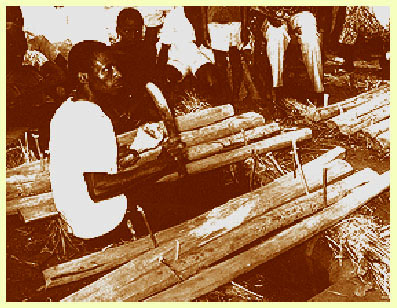Photo: ?
|
DOSO DAHO - The keys, or wooden slats, of xylophones are often fitted with resonators to amplify the tones. The resonators can take the shape of small separate devices as in the Malinké bala or a common sound-box, as is the case in the Asian and Indonesian versions, or even a pit dug into the ground, as here, in the xylophone called aso or doso in Benin. Composed of two instruments, this is doubtless the largest xylophone of its type in the world. The longest keys are huge beams measuring 1.8 meters. The keyboard of the big instrument (doso daho) is always divided into two sections: one to the left of the musician who is seated between them, resting his legs in the pit which acts as a resonator. The keys lie parallel to one another over and across the pit, which is about 70 centimeters deep and almost 2 meters wide. The musician strikes the left-hand keys (the bass) with a club of fairly soft wood and the right-hand keys with a heavy crooked beater made of extremely hard wood. The keyboard of the small instrument (doso kpevi) is set above another shallower pit. Its role is to provide a melodic and rhythmic ostinato as a cue for the main xylophone which renders the different themes designed to persuade each deity to dance at the ceremonies for the vodun. A pair of rattles and an iron bell always complete a performance on the double xylophone, which is also often accompanied by songs. |
